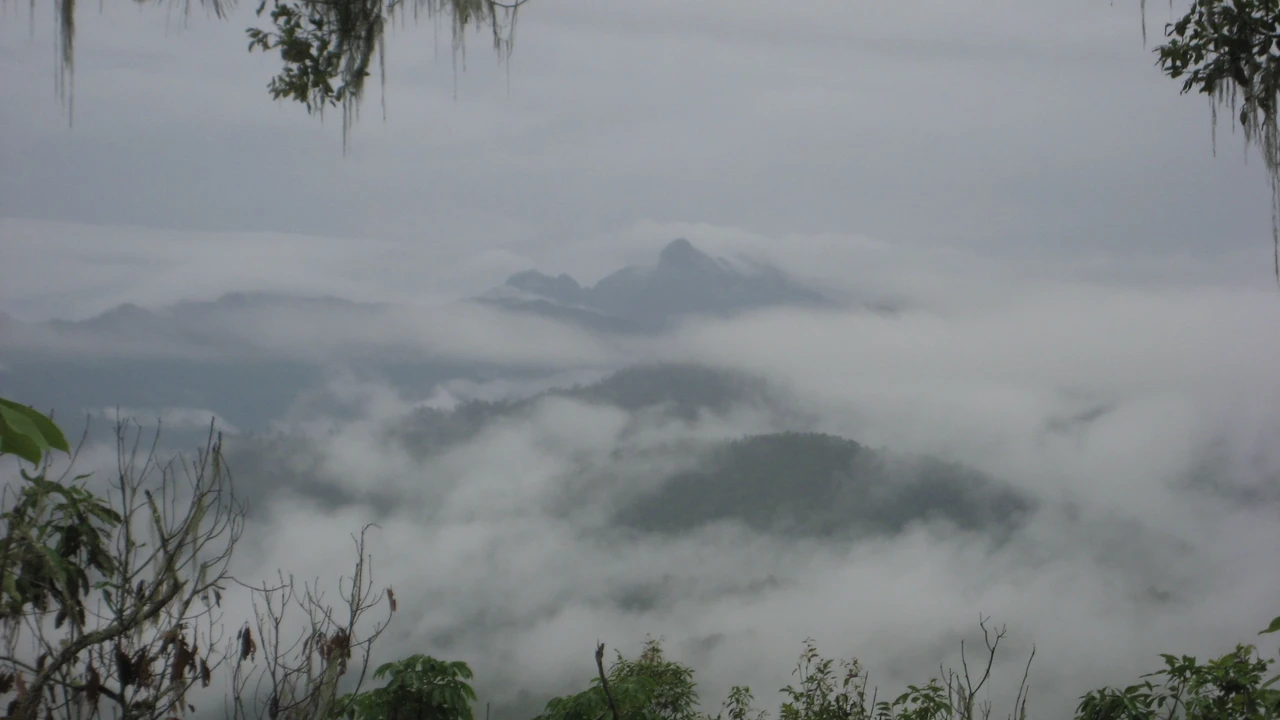Hiking in Northern Thailand: Exploring the Mountains

Why Northern Thailand is a Hiker's Paradise Hiking Trails and Scenery
Okay, so you're thinking about hiking in Northern Thailand? Smart move! Forget crowded beaches and bustling cities, Northern Thailand is where the real adventure begins. Think lush jungles, towering mountains, hidden waterfalls, and ancient temples nestled amongst the greenery. It's seriously breathtaking. The air is cleaner, the pace is slower, and the scenery? Unbeatable. We're talking postcard-perfect views around every corner. From Chiang Mai to Chiang Rai and beyond, there are hiking trails for every skill level, from gentle strolls to challenging multi-day treks. But what makes it so special? Let's dive into the details...
First off, the biodiversity is insane. You'll be walking through landscapes teeming with life - exotic birds, colorful butterflies, and maybe even a glimpse of some shy wildlife. Keep your eyes peeled! The climate is also a major plus. While it can get hot and humid, especially during the rainy season (June-October), the cooler months (November-February) offer perfect hiking weather. Think sunny days and comfortable temperatures. Plus, the local culture adds another layer of richness to the experience. You'll likely encounter hill tribe villages along your route, offering a unique glimpse into traditional ways of life. It's not just a hike; it's a cultural immersion.
But don't just take my word for it. Picture this: you're trekking through a dense jungle, the only sounds are the chirping of birds and the rustling of leaves. Suddenly, you emerge onto a ridge overlooking a valley blanketed in mist. The sun is just starting to peek through the clouds, painting the landscape in a golden glow. It's a moment that will stay with you long after you've hung up your hiking boots. That's the magic of hiking in Northern Thailand.
Choosing the Right Hiking Gear for Northern Thailand Hiking Boots Backpacks and More
Alright, let's talk gear. You can't just rock up in flip-flops and expect to conquer these mountains. Proper preparation is key to a safe and enjoyable hike. So, what do you need? Let's break it down:
- Hiking Boots: This is non-negotiable. Invest in a good pair of waterproof hiking boots with ankle support. You'll be navigating uneven terrain, slippery rocks, and potentially muddy trails. Blisters are your enemy, so make sure they're well broken-in before you hit the trails. I personally recommend the Salomon X Ultra 4 Mid GTX. They're lightweight, waterproof, and offer excellent traction. Another great option is the Merrell Moab 2 Vent. They're more budget-friendly and super comfortable, especially in warmer weather.
- Backpack: Choose a backpack that's the right size for your needs. For day hikes, a 20-30 liter pack should suffice. For multi-day treks, you'll need something larger, around 50-70 liters. Look for features like adjustable straps, a comfortable hip belt, and plenty of pockets for organizing your gear. The Osprey Atmos AG 65 is a fantastic option for longer treks, offering superior comfort and ventilation. For day hikes, the Deuter Speed Lite 20 is a lightweight and versatile choice.
- Clothing: Pack lightweight, breathable clothing that wicks away moisture. Avoid cotton, as it takes ages to dry and can make you cold. Quick-drying hiking pants or shorts, a moisture-wicking t-shirt, and a fleece jacket are essential. Don't forget a waterproof jacket and pants in case of rain.
- Other Essentials: Water bottle or hydration pack (at least 2 liters of water), sunscreen, insect repellent, a hat, sunglasses, a first-aid kit, a headlamp or flashlight, a map and compass (or a GPS device), and a whistle.
Product Recommendations & Comparisons:
- Hiking Boots:
- Salomon X Ultra 4 Mid GTX: Best overall, waterproof, great traction. Price: $160-$200. Ideal for varied terrain and all weather conditions.
- Merrell Moab 2 Vent: Best budget-friendly, comfortable, breathable. Price: $100-$130. Great for warmer weather and less technical trails.
- Comparison: The Salomon is more durable and waterproof, making it better for challenging hikes. The Merrell is more comfortable and breathable, making it better for casual hikes in warmer weather.
- Backpacks:
- Osprey Atmos AG 65: Best for multi-day treks, comfortable, excellent ventilation. Price: $250-$300. Ideal for carrying heavy loads on long hikes.
- Deuter Speed Lite 20: Best for day hikes, lightweight, versatile. Price: $80-$100. Great for carrying essentials on shorter hikes.
- Comparison: The Osprey is larger and more comfortable, making it better for multi-day treks. The Deuter is smaller and lighter, making it better for day hikes.
- Water Filters:
- Sawyer Squeeze Water Filter: Lightweight and reliable, removes bacteria and protozoa. Price: $30-$40. Perfect for filtering water from streams and rivers.
- LifeStraw Personal Water Filter: Simple and easy to use, filters water directly from the source. Price: $20-$30. Great for emergency situations and quick hydration.
- Comparison: The Sawyer Squeeze is more versatile and can filter larger quantities of water. The LifeStraw is more compact and easier to use on the go.
Top Hiking Trails in Northern Thailand Difficulty Levels and Scenic Views
Okay, you're geared up and ready to go. But where should you hike? Northern Thailand has a ton of trails, each with its own unique charm. Here are a few of my favorites, broken down by difficulty level:
- Easy: Doi Suthep Temple Trail (Chiang Mai): This is a classic hike that's perfect for beginners. It's a relatively short and easy climb to the iconic Doi Suthep temple, offering stunning views of Chiang Mai. The trail is well-maintained and mostly shaded, making it a pleasant hike even on hot days. You can also take a songthaew (red truck) up to the temple and hike down if you prefer.
- Moderate: Kew Mae Pan Nature Trail (Doi Inthanon): Located in Doi Inthanon National Park, this trail offers breathtaking views of the surrounding mountains and valleys. It's a loop trail that takes about 2-3 hours to complete. The terrain is a bit more challenging than the Doi Suthep trail, with some steep sections and uneven footing. But the views are definitely worth the effort.
- Challenging: Chiang Dao Mountain Trek: For experienced hikers looking for a real adventure, the Chiang Dao Mountain trek is a must-do. This multi-day trek takes you to the summit of Chiang Dao Mountain, the third highest peak in Thailand. The trail is steep and challenging, but the panoramic views from the top are incredible. You'll need to hire a local guide for this trek, as the trail is not well-marked.
Remember to always check the weather forecast before you go and be prepared for changing conditions. Also, be respectful of the local culture and environment. Pack out everything you pack in, and avoid making excessive noise.
Understanding Local Culture and Etiquette Respecting Hill Tribes and Traditions
Hiking in Northern Thailand isn't just about the scenery; it's also about the culture. You'll likely encounter hill tribe villages along your route, and it's important to be respectful of their traditions and customs. Here are a few things to keep in mind:
- Dress respectfully: Avoid wearing revealing clothing, especially when visiting temples or villages.
- Ask permission before taking photos: Not everyone is comfortable being photographed, so it's always best to ask first.
- Be mindful of your actions: Avoid public displays of affection, and be careful not to damage any property.
- Learn a few basic Thai phrases: Knowing a few basic phrases like "Sawasdee" (hello) and "Khop Khun" (thank you) can go a long way.
- Support local businesses: Buy souvenirs from local artisans and eat at local restaurants.
By being respectful of the local culture, you'll not only have a more enjoyable experience, but you'll also help to preserve the traditions and way of life of the hill tribe communities.
Safety Tips for Hiking in Northern Thailand Avoiding Hazards and Staying Safe
Safety first! Hiking in Northern Thailand can be an amazing experience, but it's important to be aware of the potential hazards and take precautions to stay safe. Here are a few tips:
- Tell someone where you're going: Always let someone know your hiking plans, including your route and expected return time.
- Hike with a buddy: It's always safer to hike with a friend or in a group.
- Stay on marked trails: Avoid wandering off the trail, as you could get lost or injured.
- Be aware of the weather: Check the weather forecast before you go and be prepared for changing conditions.
- Carry plenty of water: Dehydration is a serious risk, especially in hot weather.
- Protect yourself from the sun: Wear sunscreen, a hat, and sunglasses.
- Be aware of wildlife: Avoid approaching or feeding wild animals.
- Carry a first-aid kit: Be prepared to treat minor injuries.
- Know your limits: Don't push yourself too hard, especially if you're not used to hiking.
By following these safety tips, you can minimize the risks and enjoy a safe and memorable hiking experience in Northern Thailand.
Best Time to Hike in Northern Thailand Weather Conditions and Seasonal Considerations
Timing is everything! The best time to hike in Northern Thailand is during the cooler months, from November to February. The weather is generally sunny and dry, with comfortable temperatures. This is also the peak tourist season, so expect to see more crowds on the trails.
The rainy season, from June to October, can be challenging for hiking. The trails can be muddy and slippery, and there's a higher risk of flash floods. However, the landscape is incredibly lush and green during this time, and you'll likely have the trails all to yourself.
The hot season, from March to May, can be extremely hot and humid. Hiking during this time can be uncomfortable and even dangerous. If you do choose to hike during the hot season, be sure to drink plenty of water and avoid strenuous activity during the hottest part of the day.
No matter when you choose to hike, be sure to check the weather forecast before you go and be prepared for changing conditions.
Transportation Options for Reaching Hiking Trailheads in Northern Thailand Getting Around and Accessing Remote Areas
Getting there is half the battle! Reaching the trailheads in Northern Thailand can be an adventure in itself. Here are a few transportation options:
- Songthaew (Red Truck): These are shared pickup trucks that serve as taxis in many towns and cities. They're a cheap and convenient way to get around, but they can be crowded.
- Tuk-Tuk: These are three-wheeled motorized vehicles that are popular for short trips. They're more expensive than songthaews, but they're also more comfortable.
- Motorbike: Renting a motorbike is a popular option for exploring the countryside. However, be sure to wear a helmet and have a valid driver's license.
- Car: Renting a car is a good option if you're traveling with a group or if you want more flexibility. However, be aware that the roads in some areas can be narrow and winding.
- Taxi: Taxis are available in most towns and cities, but they can be more expensive than other options.
- Local Bus: Local buses connect most of the major towns and cities in Northern Thailand. They're a cheap and reliable way to travel, but they can be slow and crowded.
For reaching more remote trailheads, you may need to hire a private car or motorbike taxi. Your guesthouse or hotel can usually help you arrange transportation.
Sustainable Hiking Practices in Northern Thailand Protecting the Environment and Supporting Local Communities
Let's leave no trace! It's important to practice sustainable hiking practices to protect the environment and support local communities. Here are a few tips:
- Pack out everything you pack in: Don't leave any trash behind, even biodegradable items.
- Stay on marked trails: Avoid creating new trails, as this can damage the environment.
- Respect wildlife: Avoid approaching or feeding wild animals.
- Support local businesses: Buy souvenirs from local artisans and eat at local restaurants.
- Conserve water: Use water sparingly, especially in dry areas.
- Minimize your impact on the environment: Avoid using single-use plastics and choose eco-friendly products.
- Educate yourself about the local environment and culture: The more you know, the better you can protect it.
By following these sustainable hiking practices, you can help to preserve the beauty of Northern Thailand for future generations.
:max_bytes(150000):strip_icc()/277019-baked-pork-chops-with-cream-of-mushroom-soup-DDMFS-beauty-4x3-BG-7505-5762b731cf30447d9cbbbbbf387beafa.jpg)






